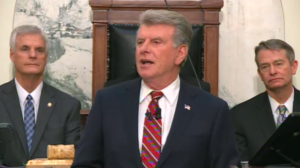Outlining an agenda heavy on education, Gov. Butch Otter called on the Legislature to increase K-12 public school spending by 7.4 percent in 2016.

Otter’s budget blueprint would increase school spending by $101,185,600, bringing the school budget bottom line to $1,475,784,000.
That amount would represent a new high-water mark for K-12 spending in Idaho, bringing expenses $57.2 million above the previous, pre-recession high from the 2009 budget year.
During his roughly 40-minute speech, Otter outlined a list of budgetary and spending priorities, making no secret where his top priority lies.
“That list begins with education,“ Otter said, garnering a warm ovation from legislators and state officials.
Last year, the Legislature approved a public school budget increase of 5.1 percent.
Otter’s budget, which is larger than former Superintendent Tom Luna’s proposed 6.9 percent increase, would bring minimum teacher salaries from $31,750 to $32,800.
Otter’s budget highlights include:
- Directing $31,929,000 to a career ladder salary proposal advanced last year by the State Board of Education. Otter called for a five-year phased approach to implementing the career ladder and increasing teacher pay.
- Spending an additional $20 million to increase discretionary funding (often called operations funding) for Idaho school districts. Otter’s plan increases spending from $22,401 to $23,600 per classroom unit. That amount still falls short of the 2009 level of $25,696 per classroom unit.
- Setting aside $17,650,000 in ongoing funding for teachers’ professional development training. Last year, the Legislature spent $8,250,000 on professional development.
- Earmarking $11 million for classroom technology and technology training. The money would be distributed to school districts based on a funding formula, and would be available for them to address their own technology needs.
- Spending $2.5 million on college and career counseling for students.
- Devoting $752,000 in ongoing funding for leadership training for school board members, administrators and superintendents.
- Investing $2.25 million in ongoing funding to pay for installation, repair, replacement and support of the wireless internet network benefitting high schools.
- Paying out $7,297,500 to keep the Idaho Education Network broadband system running through the 2016 budget year.
“The kind and quality of courses and the level of instruction provide by the IEN is truly staggering,” Otter said. “I believe its value is beyond question. The IEN is an asset that must be maintained. The challenge is continuing this world-class education tool can and should be overcome.”
Otter then called on the Legislature to keep the IEN running without disruption and to re-bid the $60 million IEN contract that District Judge Patrick Owen threw out in November.
Otter built his budget around a projection that state revenues would increase by 5.5 percent in 2015-16, which is how he would pay for spending plan. The individual income tax, corporate income tax and sales tax are the state’s three largest source of revenue — accounting for about 95 percent of revenues.
On Thursday, members of the Legislature’s Economic Outlook and Revenue Assessment Committee voted to back Otter’s revenue estimate, calling it a “reasonable” estimate to begin building the state budget around.
Otter’s budget proposal is by no means the last word on next year’s school budget. Superintendent Sherri Ybarra will present her own budget request on Jan. 29.
“We are on the same page,” Ybarra told KTVB after listening to the governor. “It was very promising to hear the governor’s budget.”
After his address, Otter said he has yet to have serious, detailed budget and policy discussions with Ybarra.
“We have just started and, in fact, I would tell you that other than some 30,000-foot level discussions we really haven’t really gotten down into the nitty gritty,” Otter said. “I would fully expect that we will be engaging very soon in some of the more details and particulars.”
On Tuesday, the Legislature’s Joint Finance-Appropriations Committee convened and devote roughly 90 days to setting the state budget.
The budget levels JFAC agrees on must be approved by both the House and the Senate – and avoid Otter’s veto stamp – to become official.
Enhanced coverage:
Otter discusses the Idaho Eduction Network contract situation during his press conference following his State of the State address:
Otter discusses his K-12 budget priorities for the 2016 budget year:
Otter discusses working with new Superintendent of Public Instruction Sherri Ybarra:
Otter responds to questioning about whether his education budget goes far enough:
